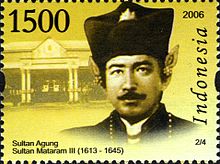Sultan Agung of Mataram
| Papa | |||||
|---|---|---|---|---|---|

Indonesian 2006 stamp featuring Sultan Agung
|
|||||
| Sultan of Mataram | |||||
| Reign | 1613 - 1645 | ||||
| Predecessor | Hanyakrawati | ||||
| Successor | Amangkurat I | ||||
| Born | Raden Mas Rangsang 1593 Kotagede |
||||
| Died | 1645 (aged 51 - 52) Kotagede |
||||
| Burial | Imogiri Royal Cemetery | ||||
| Spouse | Queen Batang | ||||
| Issue | Amangkurat I | ||||
|
|||||
| House | Royal House of Mataram | ||||
| Father | Hanyakrawati | ||||
| Mother | Queen Dyah Banawati | ||||
| Religion | Islam | ||||
| Regnal name | |
|---|---|
| Hanyakrakusuma |
Sultan Agung of Mataram, Sultan Agung Anyokrokusumo or Sultan Agung Hanyokrokusumo (Ha and A are both written using the same character in Javanese script) (1593 – 1645) was the third Sultan of Mataram in Central Java ruling from 1613 to 1645. A skilled soldier he conquered neighbouring states and expanded and consolidated his kingdom to its greatest territorial and military power.
Sultan Agung (literally, "Great Sultan" or "Majestic Sultan") is subject of a substantial amount of literature due to his legacy as a Javanese ruler, a fighter against the incursions of the Dutch East India Company, a conqueror, and his existence within a cultural framework where myth and magic are well intertwined with verifiable historical events and personages.
Sultan Agung became the ruler of Mataram in 1613 and the next year attacked Surabaya, as well as Malang which lies south of Surabaya, and the eastern end of the Java island, but failed to conquer them both. He was however able to extraxt a significant indemnity and used this in 1615, to conquer Wirasaba (present day Mojoagung, near Mojokerto), an operation which he personally lead. In 1616, Surabaya attempted to attack Mataram in retaliation, but lacking allies the Surabaya army was crushed by Sultan Agung's forces in Siwalan, Pajang (near Surakarta). The coastal city of Lasem, near Rembang, was conquered later in 1616, and Pasuruan, south-east of Surabaya, was taken in 1617. Tuban, one of the oldest and biggest cities on the coast of Java, was taken in 1619.
Surabaya had been Mataram's most formidable adversary thus far. Agung's grandfather, Senapati or Senopati, had not felt strong enough to attack this powerful city, and his father, Panembahan Seda Krapyak, attacked it to no avail. Sultan Agung weakened Surabaya by capturing Sukadana, Surabaya's ally in southwest Kalimantan, in 1622, and the island of Madura, another ally of Surabaya, in 1624 after a fierce battle. After five years of war Agung finally conquered Surabaya in a siege in 1625. With Surabaya brought into the empire, the Mataram kingdom encompassed all of central and eastern Java, and Madura, except for the west and east end of the island and its mountainous south (except for Mataram, of course). In the west Banten and the Dutch settlement in Batavia remained outside Agung's control.
...
Wikipedia
